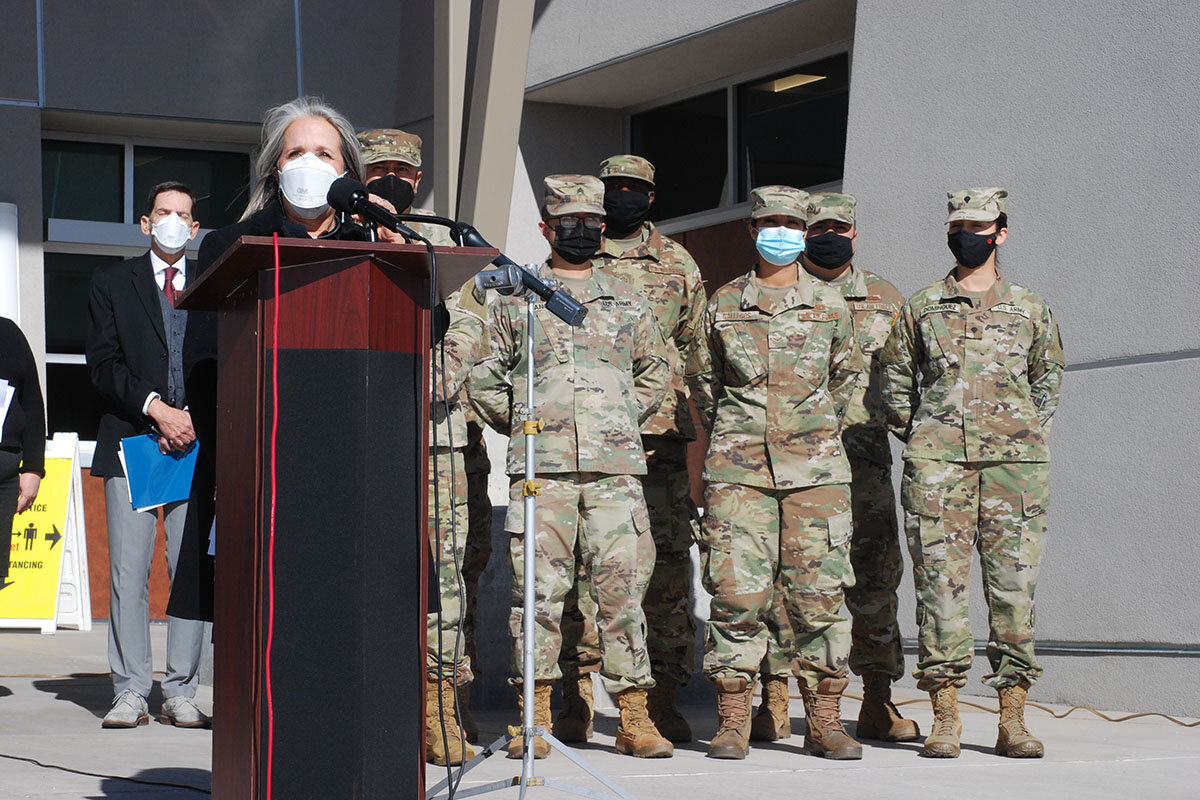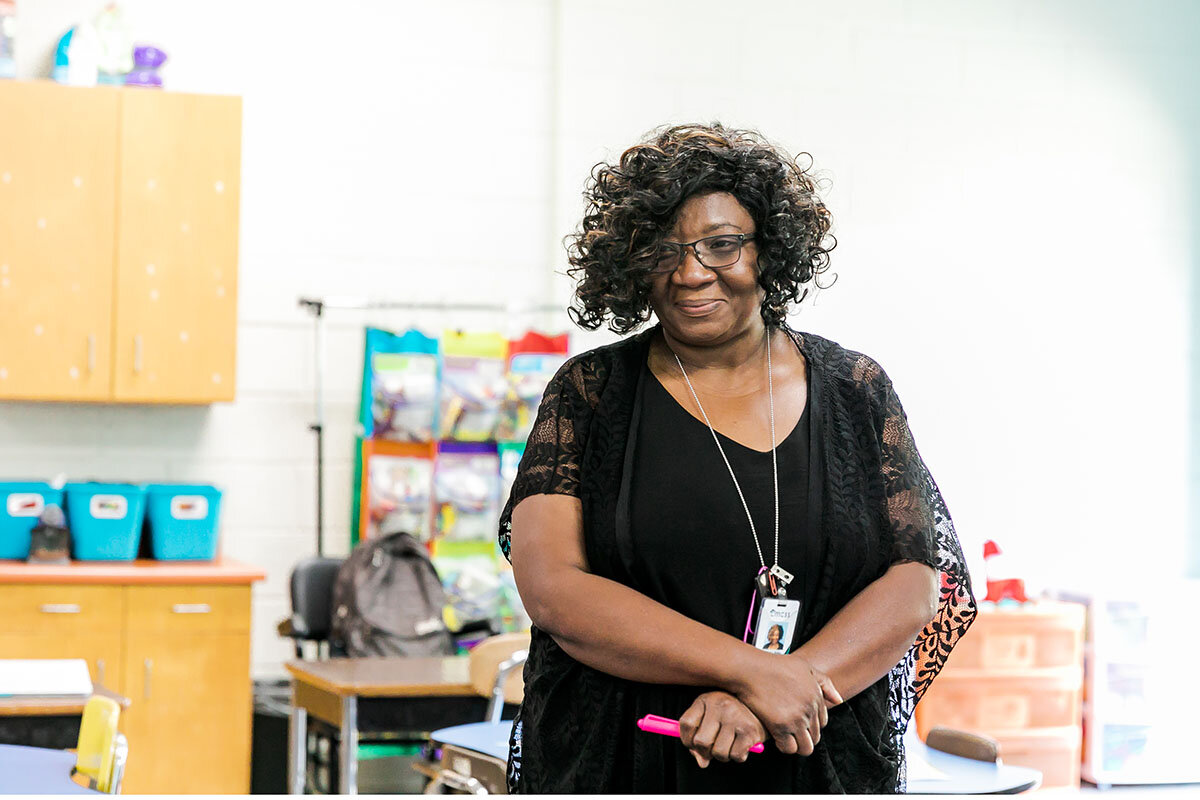What happens to US education if there’s no one to teach?
Loading...
| BOSTON; and GRANBY, COLO.
Is “blar” a word? Karina Sandoval wonders aloud, chuckling as she marks up first grade papers at her Granby Elementary School desk.
It’s a mid-January afternoon at the rural Colorado school bordered by snowbanks, and it’s time to collect students from music class. Mrs. Sandoval settles them for snack time.
As natural as she is, she is not a first grade teacher. She’s a local parent who became certified to serve as a substitute this school year.
Why We Wrote This
Staff shortages have become a pandemic struggle for public education. School systems are seeking creative interim solutions, but also need to face longer-term challenges with recruiting and retaining teachers.
“It was an opportunity to help,” says Mrs. Sandoval, who has a kindergartner in the East Grand School District, where some 1,350 students are adjusting to more staff shortages than usual. Mrs. Sandoval’s gained not only ideas for coaching her own child academically, she says, but also new respect for teachers. “We don’t realize, on the outside, how much work they do in here.”
The United States was already dealing with some teacher shortages before March 2020, with warnings about a looming crisis stretching back more than a decade. Short-term outages by educators to recover from COVID-19 and aid family members have exacerbated vacancies, which include support staff. As the pandemic spills into a third school year, governors have had to call up the National Guard to do everything from drive buses (Massachusetts) to teach class (New Mexico).
Coming at a time of slipping test scores and plummeting social-emotional skills after prolonged remote schooling, the shortages, while anecdotal, are causing consternation both in city halls and at kitchen tables. Schools are a vital tool for America and its children to really recover from the pandemic. And more Americans are questioning whether public education is up to the task. Some 54% of Americans say they are dissatisfied with the quality of U.S. K-12 schools, while only 46% approve, according to Gallup. That dissatisfaction is up 7 percentage points from 2019, before the pandemic.
Amid the stress, community members are stepping in to help, and politicians and school leaders are exploring immediate stopgaps to help maintain in-person learning, as well as initiatives to attract more sustainable talent long-term.
- The governors of Oklahoma and North Carolina issued executive orders allowing state employees to serve as substitute teachers in public schools without losing their regular jobs or pay.
- The governor of New Mexico called up the National Guard to serve as substitutes, and is volunteering as a substitute teacher herself.
- Governors in at least six states (Alabama, Georgia, Idaho, Kentucky, Mississippi, New Mexico) are calling for raising teacher salaries.
A lot is at stake for the U.S. – and for state and local elected officials, if they can’t deliver. Economic recovery from the pandemic requires that parents are able to get back to uninterrupted workweeks, guaranteeing consistent paychecks and open businesses. Schools also need time to prepare the students who down the road will help fuel America’s growth, but who right now are struggling with math.
“There is absolutely a hunger for using this moment to enact broader policy change, and at the same time there is just a struggle with the capacity to do so,” says Desiree Carver-Thomas, policy analyst at the Learning Policy Institute in Palo Alto, California. “It’s a balancing act between trying to keep schools afloat and trying to think about the big picture and long-term picture.”
“I’ve never been more tired”
Behind current pandemic-related staffing problems lurk longtime challenges with recruiting and retaining teachers, says Lynn Olson, a senior fellow at the FutureEd think tank at Georgetown University, and co-author of an October 2021 report on teacher shortages.
Underlying problems include turnover and declining enrollment in teacher preparation programs. Among many of the country’s more than 13,000 districts, there exists a surplus of elementary or social studies teachers, but there aren’t enough teachers of color; teachers who specialize in science, math, foreign language, or special education; and those willing to work in rural or urban locations, according to the report.
Districts and states are tapping into their shares of about $190 billion in federal COVID-19 relief for K-12 education to try to fix some of the short- and long-term challenges. In addition to the handful of states looking to raise salaries, Los Angeles Unified School District offered a 5% pay boost this school year. Some states, like Tennessee and Minnesota, are investing federal funding in expanded Grow Your Own teacher initiatives, programs that recruit and financially support potential teachers from local communities.
Some research suggests that teacher retention rates rose in at least a half-dozen states earlier in the pandemic, says Chad Aldeman, policy director at Edunomics Lab at Georgetown University. So far data doesn’t point to a “mass exodus of people that are causing the vacancies,” he adds. Districts may be trying to rebound after fewer hires last year, for instance, and have more funds to put toward hiring due to government aid.
Cherry Hill Public Schools in southern New Jersey has “actually turned over fewer staff in the last two years than we typically do,” in terms of certified staff like teachers, says Superintendent Joseph Meloche. Currently, however, educational assistant and facilities jobs represent the most vacancies.
Even so, teachers are reporting higher levels of stress and more are considering leaving the profession than in pre-pandemic years, according to surveys. In Michigan, 44% more teachers retired midyear in the 2020-2021 school year than in the year prior, according to local reporting.
Nearly all – about 96% – of U.S. schools were operating in person as of Jan. 23. However, there is continued debate across the country about that approach, with teachers unions and some students pushing for stronger safety precautions and cautioning about prolonged effects from the pandemic and staff shortages.
Though “safe, in-person learning is what’s best for kids,” says Kisha Borden, president of the San Diego Education Association, there are trade-offs. A lack of substitutes has cut into teachers’ professional development time and ability to take days off. Plus, the merging of some classes into spaces like auditoriums has spurred more than health concerns, she adds: “When you put several classes together, the learning suffers.”
Substantial vacancies in schools nationwide in positions such as bus driver, cafeteria worker, and substitute teacher are well documented, leading to more teachers having to cover for other tasks.
“Low-income and minoritized students are more likely to be taught, in general, by less qualified teachers. They also experience more teacher absences than higher-income peers,” and have less access to substitute teachers, says Christopher Redding, an assistant professor of educational leadership at the University of Florida. “All of which can play a role in reducing the stable learning environment.”
Kristin Humphries, superintendent of East Moline School District 37 in Illinois, along with colleagues, recently served middle schoolers pizza for lunch. Stepping in has become a theme this year for Dr. Humphries, who’s helped in a number of positions including paraprofessional, playground monitor, principal, and bus dispatcher.
“This is my 28th year in education. ... I’ve never been more tired,” he says. Still, “I’ve never seen more people just jump to it and do whatever it takes. Everybody’s tired, but they know this is an important mission.”
“What can we do together?”
Mrs. Sandoval in Colorado considered substitute teaching after hearing about widespread school staffing needs on the news. She’s conflicted about whether it’s safe to work around so many people, since her family battled COVID-19 in 2020, but plans to continue subbing for now. “I enjoy being with the kids,” she says.
Another mother, Nicole Rukstalis in Milton, Massachusetts, contacted her school district in early January to see how she could substitute-teach. The college professor supported moving school online at the pandemic’s start, but the availability of vaccines and reports on learning loss and student well-being changed her mind.
On social media she encouraged other parents with flexible work schedules to substitute. “My goal wasn’t to say, ‘I’m awesome,’ but ‘What can we do together?’ Ten people might make a difference,” she says.
Elsewhere, one district is reaping benefits from experimenting with new ways to recruit teachers. Clarksville-Montgomery County School System (CMCSS), a district of about 38,000 students in northwest Tennessee, started a teacher residency program in 2018, which was recently named the country’s first registered teacher apprenticeship program by the U.S. Department of Labor. Residents can earn a bachelor’s or master’s degree and their teacher license for free, while working alongside a teacher and committing to work for the district.
Traci Koon, CMCSS educator pipeline facilitator, says the program has been “instrumental” in helping keep operations going this year, with teacher residents covering classes and helping with lesson plans. The district expects to place about 75 to 80 teachers annually through the program and recruited more diverse candidates in its first cohorts, better reflecting the student body.
Back in Colorado, East Grand School District Superintendent Frank Reeves says being more intentional about soliciting community member assistance is one strategy that might stick moving forward.
“What we’re really finding out is there’s so many really positive, awesome people that can work with our kids,” he says.







